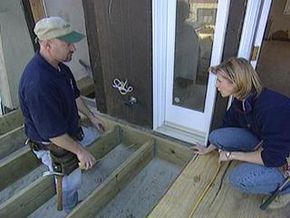Home Improvement

Lag screws, also known as lag bolts, are some of the strongest screws available. They are primarily used to connect heavy lumber and materials that carry a significant load. Unlike wood screws, sheet metal screws, and self-drilling screws, lag screws have their own specific purpose and differ in their design.
Wood screws, for example, are used to join wood to wood and have a coarse threading that only goes partway up. They differ from lag screws in that they thread their way through the wood when screwed in, whereas a hole must be drilled before using a lag screw. Lag screws require a nut on one side to hold everything together, while wood screws’ tight fit eliminates the need for a nut. However, since wood screws are smaller and don’t use nuts, they cannot bear the same loads as lag screws. Sheet metal screws, on the other hand, have threads all along the shaft and are used when screwing through metal, even when attaching metal to wood. Self-drilling or self-tapping screws are similar to sheet metal screws, but they cut their holes as they are driven in, eliminating the need to pre-drill a hole.
Unlike wood screws, sheet metal screws, and self-tapping screws, lag screws only come with hex heads. A nut driver or ratchet is required to drive in screws with hex heads, which are used when a lot of torque is needed. Other screw types have various head shapes and are compatible with different drivers. Some have slotted heads, while others have Philips heads. Torx drive screws are one exception.
FAQ
1. What are lag screws and how are they used?
Lag screws, also known as lag bolts, are large screws with a hexagonal head and a pointed tip. They are commonly used to attach heavy objects to wood, such as building structures, decks, and furniture. The pointed tip allows for easy insertion into the wood, while the large size and threading provide a strong hold. Lag screws are typically installed using a drill or impact driver.
2. How do I choose the right size of lag screw?
The size of the lag screw needed will depend on the weight of the object you are attaching and the type of wood it is being attached to. As a general rule, the length of the screw should be at least 2.5 times the thickness of the wood. It is also important to choose a screw with the right diameter, as a larger diameter will provide a stronger hold. It is recommended to consult a professional or follow a chart to determine the appropriate size for your specific project.
3. Are lag screws better than regular screws?
Lag screws are typically stronger than regular screws due to their larger size and threading. They are able to hold more weight and provide a stronger hold, making them ideal for heavy-duty applications. However, regular screws may be more appropriate for smaller projects or lighter weight items.
4. Can lag screws be used in concrete?
No, lag screws are designed specifically for use in wood and should not be used in concrete or masonry. Instead, concrete screws or anchors should be used for these applications.
5. What is the maximum weight a lag screw can hold?
The maximum weight a lag screw can hold will depend on the size of the screw and the type of wood it is being attached to. As a general rule, a 1/4-inch lag screw can hold up to 100 pounds in a vertical application and up to 250 pounds in a horizontal application. It is important to consult a professional or follow a chart to determine the appropriate weight limit for your specific project.
6. Are there different types of lag screws?
Yes, there are different types of lag screws available, including those with different head types, thread types, and materials. Some common types include hex head, flat head, and Phillips head lag screws. Thread types can vary as well, with some screws having coarse threads for soft woods and others having fine threads for hard woods. Additionally, lag screws can be made from different materials, such as stainless steel or zinc-plated steel, depending on the intended use and environment.
7. Can lag screws be used in outdoor applications?
Yes, lag screws can be used in outdoor applications as long as they are made from a material that is appropriate for the environment. For example, stainless steel lag screws are often used for outdoor applications as they are resistant to corrosion. It is important to choose the right material and follow proper installation techniques to ensure the longevity and safety of the project.
8. Can lag screws be removed and reused?
Yes, lag screws can be removed and reused if they are in good condition. However, it is important to inspect the screw and the wood it was attached to for any damage or wear that may affect the strength of the hold. It is also recommended to use a new screw if it will be used for a heavy-duty application.
9. How do I install lag screws?
To install lag screws, first drill a pilot hole that is slightly smaller than the diameter of the screw. Then, insert the screw into the hole and use a drill or impact driver to tighten it until it is snug. It is important not to overtighten the screw as this can cause the wood to split or damage the screw threads.
10. Are there any safety precautions I should take when using lag screws?
Yes, it is important to wear appropriate safety gear, such as eye protection and gloves, when using lag screws. It is also important to follow proper installation techniques to avoid injury or damage to the project. Additionally, it is recommended to consult a professional or follow a guide when working with lag screws for the first time.

Brody is a skilled craftsman and gardening expert. From renovating living spaces to cultivating lush gardens, Brody’s knowledge and passion shine through, inspiring readers to embark on their own home improvement and gardening journeys with confidence.






Leave a Reply